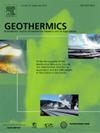天津地热资源开发与储层动态
IF 3.9
2区 工程技术
Q3 ENERGY & FUELS
引用次数: 0
摘要
地热储层动态监测与研究是优化资源开发、保证资源可持续利用、降低开发风险的重要科学依据。本文系统整理了天津市近50年来的地热利用需求和管理政策,以及多孔(如馆陶组)和裂缝(如雾雾山组)储层的应用场景、抽注量、热储水位、水化学成分、井口温度和热储温度等数据。分析了市场需求、政策调控与库区资源动态特征之间的关系。研究结果表明:(1)耗水量的减少是水位由下降向恢复转变的直接原因。尽管多孔和裂缝性储层的响应是同步的,但它们的模式不同。在多孔油藏中,未经许可的井突然关闭导致非回注采收率急剧下降,导致水位从快速下降过渡到快速恢复,然后缓慢恢复(“V”型响应)。相比之下,裂缝性油藏由于持续的回注增加,消耗逐渐减少,导致从缓慢下降到缓慢然后快速恢复(“U”型响应)。(2)两个储层的水化学成分保持稳定,地下化学环境没有明显变化,但部分井的碳酸钙结垢影响了回注效率。(3)多孔储层过低的回注温度有冷锋从注入井运移的危险,造成热突破威胁,而裂缝性储层温度保持稳定,特别是在深部导电断层附近,由于深部热源的存在,具有很高的开发潜力。天津的大规模回注实践对重建热储平衡具有重要意义,为类似地区的可持续地热开发提供了有价值的见解。本文章由计算机程序翻译,如有差异,请以英文原文为准。
Geothermal resource development and reservoir dynamics in Tianjin, China
Geothermal reservoir dynamic monitoring and research serve as the key scientific foundation for optimizing resource development, ensuring sustainable utilization, and mitigating exploitation risks. This paper systematically compiles nearly 50 years of geothermal utilization demand and management policies in Tianjin, along with data on application scenarios, extraction/injection volumes, thermal reservoir water levels, hydrochemical components, wellhead temperatures, and thermal reservoir temperatures for both porous (e.g., Guantao Formation) and fractured (e.g., Wumishan Formation) reservoirs. It analyzes the relationships among market demand, policy regulation, and the dynamic characteristics of reservoir resources. The findings indicate: (1) Reduced consumption is the direct cause of the shift from declining to recovering water levels. Although porous and fractured reservoirs respond synchronously, their patterns differ. In porous reservoirs, abrupt shutdowns of unlicensed wells led to a sharp decline in non-reinjected extraction, causing water levels to transition from rapid decline to rapid and then slow recovery (a "V"-shaped response). In contrast, fractured reservoirs exhibited gradual consumption reduction due to sustained reinjection increases, resulting in a shift from slow decline to slow and then rapid recovery (a "U"-shaped response). (2) Hydrochemical components in both reservoirs remained stable, with no significant alteration to the subsurface chemical environment, though calcium carbonate scaling in some wells impaired reinjection efficiency. (3) Overly low reinjection temperatures in porous reservoirs risked cold front migration from injection wells, posing thermal breakthrough threats, whereas fractured reservoirs maintained stable temperatures—especially near deep conductive faults, demonstrating high exploitation potential due to deep heat sources. Tianjin’s large-scale reinjection practices hold significant implications for reestablishing thermal reservoir equilibrium, offering valuable insights for sustainable geothermal development in similar regions.
求助全文
通过发布文献求助,成功后即可免费获取论文全文。
去求助
来源期刊

Geothermics
工程技术-地球科学综合
CiteScore
7.70
自引率
15.40%
发文量
237
审稿时长
4.5 months
期刊介绍:
Geothermics is an international journal devoted to the research and development of geothermal energy. The International Board of Editors of Geothermics, which comprises specialists in the various aspects of geothermal resources, exploration and development, guarantees the balanced, comprehensive view of scientific and technological developments in this promising energy field.
It promulgates the state of the art and science of geothermal energy, its exploration and exploitation through a regular exchange of information from all parts of the world. The journal publishes articles dealing with the theory, exploration techniques and all aspects of the utilization of geothermal resources. Geothermics serves as the scientific house, or exchange medium, through which the growing community of geothermal specialists can provide and receive information.
 求助内容:
求助内容: 应助结果提醒方式:
应助结果提醒方式:


